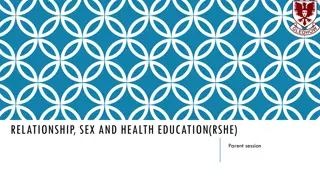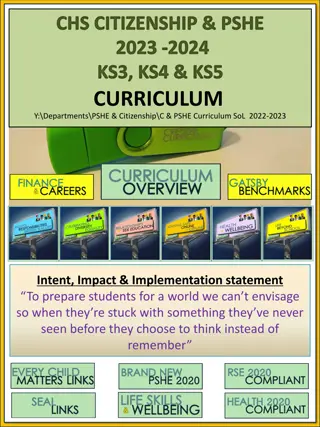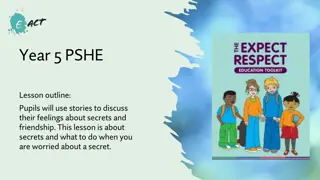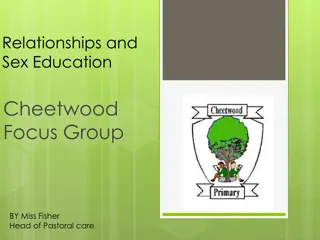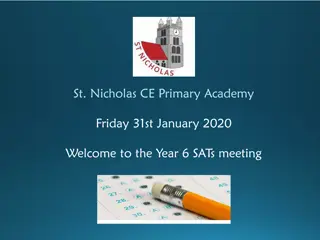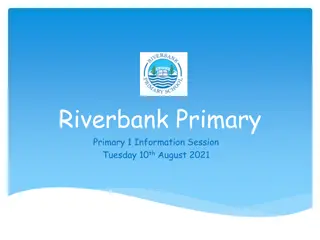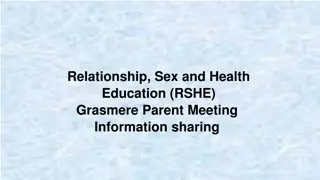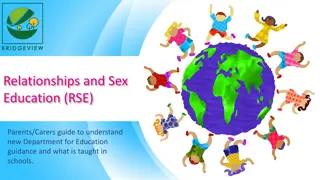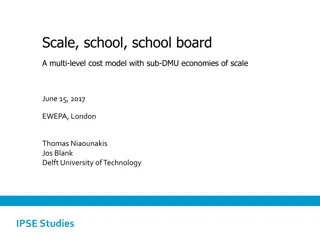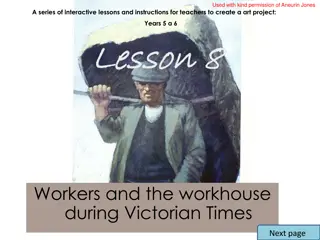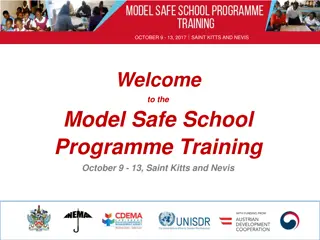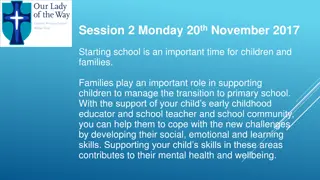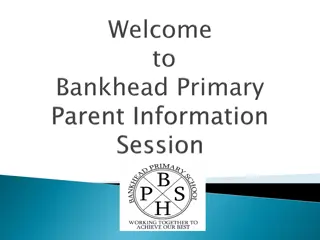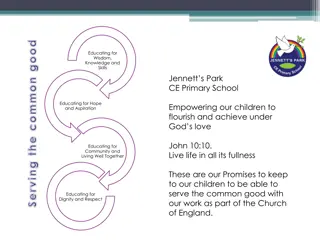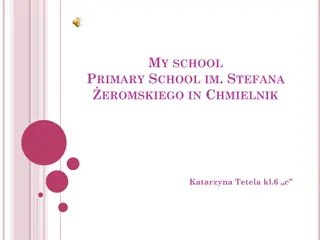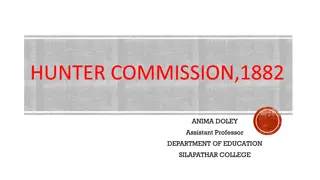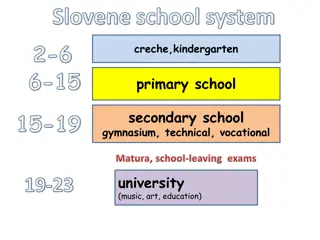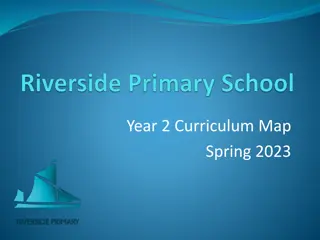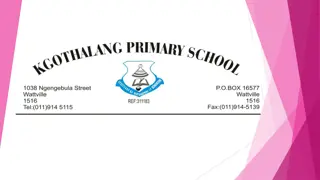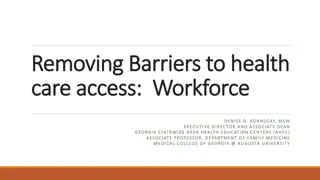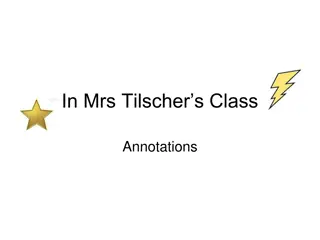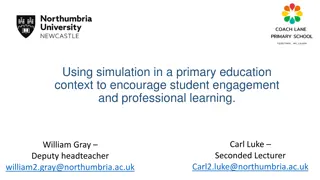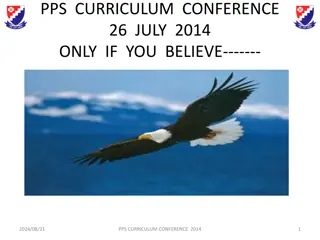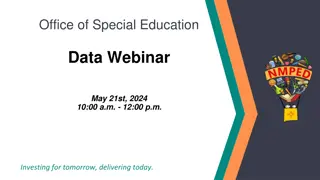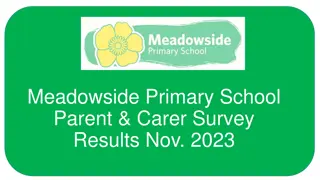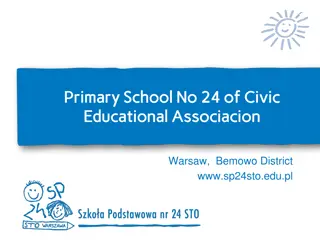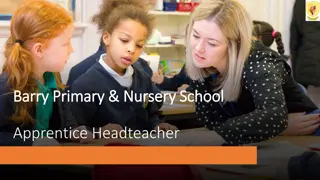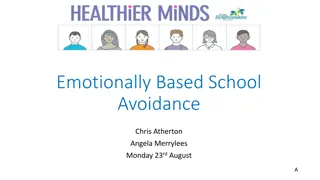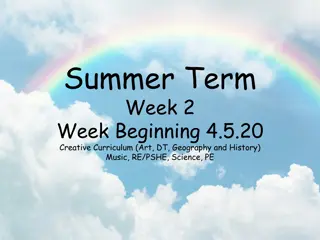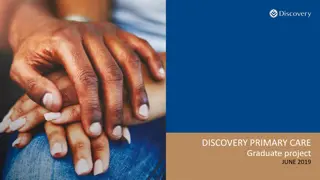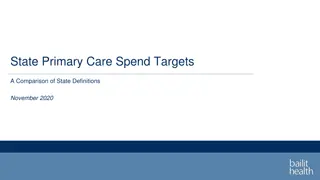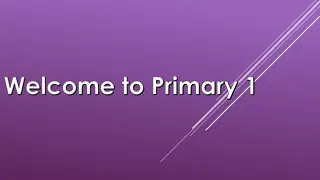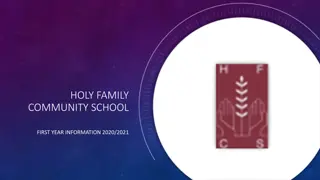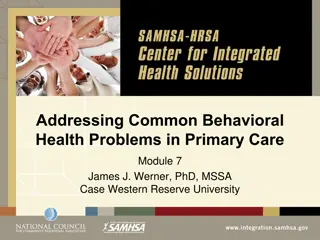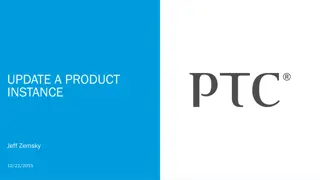PSHE and Relationship Education at St. Nicholas Primary School
St. Nicholas Primary School incorporates Personal, Social, Health and Economic Education (PSHE) along with Relationship and Sex Education (RSE) in their curriculum. The school follows the Jigsaw scheme, focusing on the holistic development of students through mindfulness and promoting British values. Relationship Education covers topics like families, respect, and caring friendships, with an emphasis on teaching positive relationship skills throughout the year.
Download Presentation

Please find below an Image/Link to download the presentation.
The content on the website is provided AS IS for your information and personal use only. It may not be sold, licensed, or shared on other websites without obtaining consent from the author. Download presentation by click this link. If you encounter any issues during the download, it is possible that the publisher has removed the file from their server.
E N D
Presentation Transcript
PERSONAL, SOCIAL, HEALTH AND ECONOMIC EDUCATION (PSHE) INCORPORATING RELATIONSHIP AND SEX EDUCATION (RSE) AT ST NICHOLAS PRIMARY SCHOOL
What do schools have to teach in PSHE Education? According to the latest guidance from the government, via the National Curriculum, every school needs to have a broad and balanced curriculum that: promotes the spiritual, moral, cultural, mental and physical development of pupils at the school and of society prepares pupils at the school for the opportunities, responsibilities and experiences of later life promotes British values
PSHE (incorporating RSE) will be taught at St Nicholas Primary School primarily through the Jigsaw scheme of work. We have chosen Jigsaw for its whole-school, holistic approach to teaching PSHE. Each year group covers the same theme at the same time of year and each half term starts with a whole-school launch assembly. The scheme is made up of six units of work called puzzles that are taught every year, with one discrete puzzle covered every half term.
The Jigsaw Approach is underpinned by mindfulness. Mindfulness is being able to observe your own thoughts and feelings as they happen, in the present moment, applying no judgement. Jigsaw teaches children to understand their thoughts and feelings and through both taught lessons and the Calm Me time exercises (using the Jigsaw chime), helping to develop their awareness, and their capacity to be mindful human beings. Learning is thus enhanced as emotions are regulated, behaviour managed and calmness generated.
Relationship Education Relationship Education is statutory, meaning that parents do not have the right to withdraw their child from this subject. Although positive relationship skills are taught throughout the year, the Jigsaw puzzle that specifically focuses on relationships is called Relationships and is taught in the first half of the Summer term.
What will children learn in Relationship Education? Throughout their time in St Nicholas Primary School children will learn in age-appropriate ways about: Families and people who care for them, including that others families, either in school or in the wider world, sometimes look different from their family, but that they should respect those differences and know that other children s families are also characterised by love and care (RSE government statutory guidance 2019) Caring friendships The importance of respecting others, even when they are very different from them (for example, physically, in character, personality or backgrounds), or make different choices or have different preferences or beliefs (RSE government statutory guidance 2019) Online relationships Being safe, including friendship boundaries, privacy and asking for help
Health Education Health Education is statutory, meaning that parents do not have the right to withdraw their child from this subject. Within Health Education lessons pupils will be taught in age- appropriate ways about mental wellbeing, internet and safety harms, physical health and fitness, healthy eating, medicines and drugs, alcohol and tobacco, health and prevention, basic first aid and the changing adolescent body (particularly from age 9 through to age 11).
Sex Education is not statutory. Sex Education is not compulsory in primary schools although, the Department continues to recommend that all primary schools should have a sex education programme tailored to the age and the physical and emotional maturity of the pupils . After scrutinising the government guidance, Jigsaw has concluded that Sex Education in primary schools consists of human reproduction , as puberty work is now included in statutory Health Education . Parents have the right to withdraw their child from Sex Education lessons as it is non-statutory. You will need to write a letter to the Head teacher every year if you wish to withdraw your child.
So, where exactly does Jigsaw teach Puberty (a statutory part of Health Education) and Human reproduction? The Changing Me puzzle contains the explicit work on these aspects. However, Jigsaw is a holistic programme that supports children s personal development, sense of identity and self- respect throughout.
The Changing Me puzzle is taught in the second half of the Summer term every year. The lessons in this puzzle deal with change of many types, from growing from young to old, becoming a teenager, assertiveness, self-respect and safeguarding. Self and body image, puberty, attraction and accepting change are diverse subjects for children to explore. Each year group thinks about looking ahead, moving year groups or the transition to secondary school. Life cycles and how babies are made and grow are treated sensitively and are designed to meet children s needs. All year groups learn about how people and bodies change. This Puzzle links with the statutory National Curriculum Science curriculum when teaching children about life cycles, babies and puberty.
The rationale for what is taught and when in Jigsaw: At St Nicholas Primary School we believe that knowledge empowers and protects children as long as it is age-appropriate. At secondary school Sex Education is statutory and we believe that primary schools should prepare children with accurate knowledge about puberty and human reproduction before they transfer to secondary school. Correct terminology for body parts is introduced early to normalise this biological vocabulary and to support safeguarding. These words are not used in isolation but always in conjunction, ensuring children know these are private parts of their bodies.
When will your child be taught about puberty? Puberty is introduced gently in Y3 because some girls may start their periods this early and it is necessary to prepare them for this, so they aren t scared or worried. Conception is introduced age-appropriately in Y4 in the context of understanding why our bodies change during puberty. Understanding of Human Reproduction, conception and puberty is built upon in Year 5 and then puberty, conception and childbirth is age-appropriately covered in Y6.
Teaching content compared Science and Jigsaw The following seven slides give full details of how Science in the statutory National Curriculum ensures that all schools teach about human and animal bodies, life cycles, plant and animal reproduction, aging and puberty. The slides also set out the non-statutory specific content and learning outcomes within the Jigsaw Changing Me puzzle. N.B Parents do not have the right to withdraw their child from Science as it is a statutory part of the National Curriculum.
National Curriculum - Science Animals, including humans Pupils should be taught to: describe and compare the structure of a variety of common animals (fish, amphibians, reptiles, birds and mammals including pets) identify, name, draw and label the basic parts of the human body and say which part of the body is associated with each sense Jigsaw Year One statutory guidance Year One non-statutory guidance Pupils should have plenty of opportunities to learn the names of the main body parts (including head, neck, arms, elbows, legs, knees, face, ears, eyes, hair, mouth, teeth) through games, actions, songs and rhymes. I am starting to understand the life cycles of animals and humans I can tell you some things about me that have changed and some things about me that have stayed the same I can tell you how my body has changed since I was a baby I can identify the parts of the body that make boys different to girls and can use the correct names for these: penis, testicles, vagina, vulva, anus
National Curriculum - Science Animals, including humans Pupils should be taught to: notice that animals, including humans, have offspring which grow into adults find out about and describe the basic needs of animals, including humans, for survival (water, food and air) describe the importance for humans of exercise, eating the right amounts of different types of food, and hygiene Jigsaw Year Two statutory guidance Year Two non-statutory guidance Pupils should be introduced to the basic needs of animals for survival, as well as the importance of exercise and nutrition for humans. They should also be introduced to the processes of reproduction and growth in animals. The focus at this stage should be on questions that help pupils to recognise growth; they should not be expected to understand how reproduction occurs. I can recognise cycles of life in nature I can tell you about the natural process of growing from young to old and understand that this is not in my control I can recognise how my body has changed since I was a baby and where I am on the continuum from young to old I can recognise the physical differences between boys and girls, use the correct names for parts of the body (penis, anus, testicles, vagina, vulva) and appreciate that some parts of my body are private I understand there are different types of touch and can tell you which ones I like and don t like The following examples might be used: egg, chick, chicken; egg, caterpillar, pupa, butterfly; spawn, tadpole, frog; lamb, sheep. Growing into adults can include reference to baby, toddler, child, teenager, adult. Pupils might work scientifically by: observing, through video or first-hand observation and measurement, how different animals, including humans, grow; asking questions about what things animals need for survival and what humans need to stay healthy; and suggesting ways to find answers to their questions.
National Curriculum - Science Animals, including humans Pupils should be taught to: identify that animals, including humans, need the right types and amount of nutrition, and that they cannot make their own food; they get nutrition from what they eat identify that humans and some other animals have skeletons and muscles for support, protection and movement Pupils should continue to learn about the importance of nutrition and should be introduced to the main body parts associated with the skeleton and muscles, finding out how different parts of the body have special functions. Jigsaw Year Three statutory guidance Year Three non-statutory guidance I understand that in animals and humans lots of changes happen between conception and growing up, and that usually it is the female who has the baby I understand how babies grow and develop in the mother s uterus I understand what a baby needs to live and grow I understand that boys and girls bodies need to change so that when they grow up their bodies can make babies I can identify how boys and girls bodies change on the outside during this growing up process I can identify how boys and girls bodies change on the inside during the growing up process and can tell you why these changes are necessary so that their bodies can make babies when they grow up Pupils might work scientifically by: identifying and grouping animals with and without skeletons and observing and comparing their movement; exploring ideas about what would happen if humans did not have skeletons. They might compare and contrast the diets of different animals (including their pets) and decide ways of grouping them according to what they eat. They might research different food groups and how they keep us healthy, and design meals based on what they find out.
National Curriculum - Science Animals, including humans Pupils should be taught to: describe the simple functions of the basic parts of the digestive system in humans identify the different types of teeth in humans and their simple functions Jigsaw Year Four Statutory guidance Year Four non-statutory guidance Pupils should be introduced to the main body parts associated with the digestive system, for example: mouth, tongue, teeth, oesophagus, stomach, and small and large intestine, and explore questions that help them to understand their special functions. I understand that some of my personal characteristics have come from my birth parents and that this happens because I am made from the joining of their egg and sperm I can correctly label the internal and external parts of male and female bodies that are necessary for making a baby I can describe how a girl s body changes in order for her to be able to have babies when she is an adult, and that menstruation (having periods) is a natural part of this Pupils might work scientifically by: comparing the teeth of carnivores and herbivores and suggesting reasons for differences; finding out what damages teeth and how to look after them. They might draw and discuss their ideas about the digestive system and compare them with models or images.
National Curriculum - Science Living things and their habitats Pupils should be taught to: describe the differences in the life cycles of a mammal, an amphibian, an insect and a bird describe the life process of reproduction in some plants and animals Pupils should study and raise questions about their local environment throughout the year. They should observe life-cycle changes in a variety of living things, for example, plants in the vegetable garden or flower border, and animals in the local environment. They should find out about the work of naturalists and animal behaviourists, for example, David Attenborough and Jane Goodall. Jigsaw Year Five Statutory guidance Year Five non-statutory guidance Pupils should find out about different types of reproduction, including sexual and asexual reproduction in plants, and sexual reproduction in animals. Pupils might work scientifically by: observing and comparing the life cycles of plants and animals in their local environment with other plants and animals around the world (in the rainforest, in the oceans, in desert areas and in prehistoric times), asking pertinent questions and suggesting reasons for similarities and differences. They might try to grow new plants from different parts of the parent plant, for example, seeds, stem and root cuttings, tubers, bulbs. They might observe changes in an animal over a period of time (for example, by hatching and rearing chicks), comparing how different animals reproduce and grow.
National Curriculum - Science Animals, including humans Pupils should be taught to: describe the changes as humans develop to old age Jigsaw Year Five statutory guidance Year Five non-statutory guidance I can explain how a girl s body changes during puberty and understand the importance of looking after yourself physically and emotionally I can describe how boys and girls bodies change during puberty I understand that sexual intercourse can lead to conception and that is how babies are usually made I also understand that sometimes people need IVF to help them have a baby I can identify what I am looking forward to about becoming a teenager and understand this brings growing responsibilities (age of consent) Pupils should draw a timeline to indicate stages in the growth and development of humans. They should learn about the changes experienced in puberty. Pupils could work scientifically by researching the gestation periods of other animals and comparing them with humans; by finding out and recording the length and mass of a baby as it grows.
National Curriculum - Science Animals including humans Pupils should be taught to: identify and name the main parts of the human circulatory system, and describe the functions of the heart, blood vessels and blood recognise the impact of diet, exercise, drugs and lifestyle on the way their bodies function describe the ways in which nutrients and water are transported within animals, including humans Jigsaw Year Six Statutory guidance Year Six non-statutory guidance Pupils should build on their learning from years 3 and 4 about the main body parts and internal organs (skeletal, muscular and digestive system) to explore and answer questions that help them to understand how the circulatory system enables the body to function. I can explain how girls and boys bodies change during puberty and understand the importance of looking after yourself physically and emotionally I can describe how a baby develops from conception through the nine months of pregnancy, and how it is born I understand how being physically attracted to someone changes the nature of the relationship and what that might mean about having a girlfriend/boyfriend Pupils should learn how to keep their bodies healthy and how their bodies might be damaged including how some drugs and other substances can be harmful to the human body. Pupils might work scientifically by: exploring the work of scientists and scientific research about the relationship between diet, exercise, drugs, lifestyle and health.




